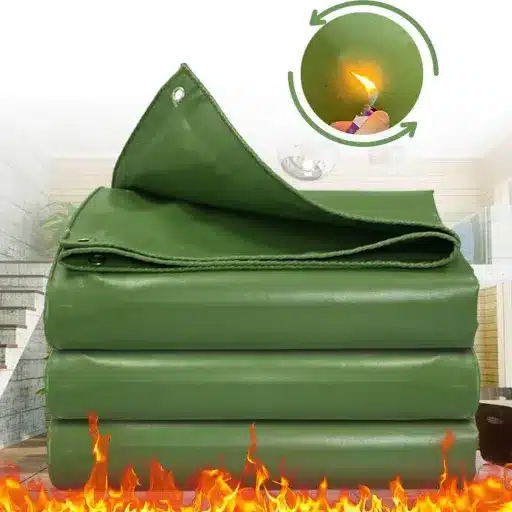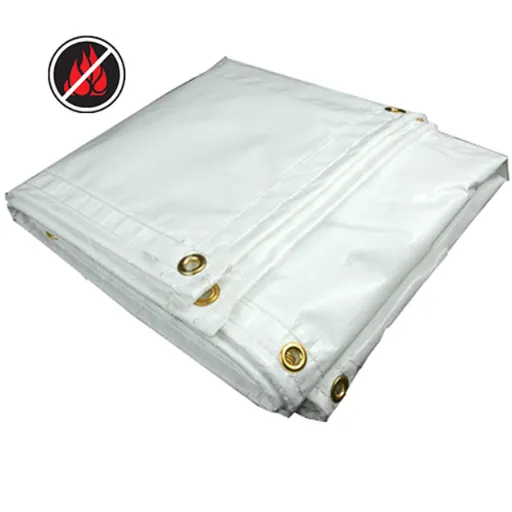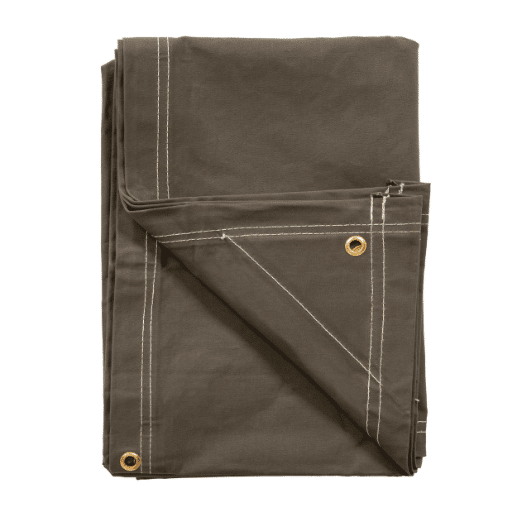When choosing a tarp, consider the factors of durability, versatility, and application-just a few things that bring all the way down to the best tarp material. Is it equipment you need to protect? Maybe a temporary shelter? Or just a minor concern for something with real outdoor endurance? The right tarp makes all the difference. This article offers a detailed comparison among the three most common tarp-making materials: vinyl, poly, and canvas. Each has its distinguishing properties, pros, and cons determined by their usefulness. Closer inspection of the three materials might just assist your choice as to which tarp material will serve you best, guaranteeing excellent-functioning capability coupled with high reliability.
Introduction to Tarp Materials
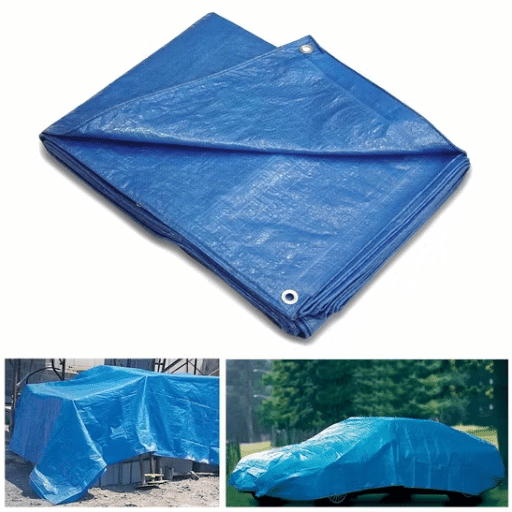
Importance of Tarps in Various Industries
Tarps find application across numerous industries, serving as essential tools for purposes of protection, coverage, and transportation. For example, in the construction industry: tarps are used to protect building materials and equipment from inclement weather so that the materials may be damaged and thus undermined by rain or, maybe, wind or UV. Similarly, in agriculture, tarps are used to offer protection against the environment to their crops and hay as well as against stress from animals to further operational efficiency.
🏭 Industry Applications
- Construction: Protection of building materials and equipment
- Agriculture: Crop protection and hay storage
- Logistics: Goods protection during transit and storage
- Industrial: Heavy-duty equipment coverage
As per recent search trends, interest in heavy-duty tarps for industrial use reflects the rising demand for good-quality materials that can stand up to a wide array of circumstances. This also points to the greater dependence on tarps for cost-effective solutions in logistics and warehousing, where this material ensures that goods are protected very well during transit and storage. By learning the specific advantages of the available tarp materials-vinyl, poly, and canvas-industries can make informed decisions depending on their operational priorities for optimum durability and performance in their applications.
Focus of the Article
The article aims to cast a general net around all the possible types of tarp materials vinyl, poly, and canvas depending on their inherent properties, benefits, and applications in different industries. Using the latest data trends from a search engine, the article will address questions that have superseded the criteria for determining worthwhile tarp materials, such as durability, cost efficiency, good weather resistance, and appropriateness for a particular use case. Such an approach will deliver practical knowledge to readers, giving them insight into choosing the right solution for their operational considerations. Through an intensive analysis, the matter under consideration will be tackled so that the answer to “Which tarp material offers the best balance of performance and cost for your application?” is unambiguously provided.
Why Strength Matters in Tarp Materials
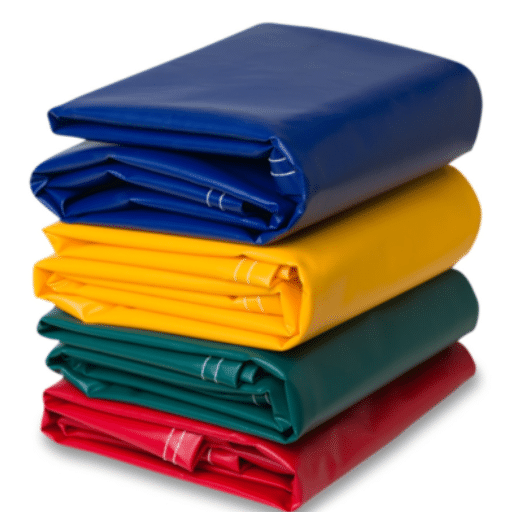
Strength-Related Factors
Tarp material strength is necessary to create durability and resistance to stress under different operational conditions. Factors that go directly into imparting strength on a tarp are tensile strength, tear resistance, material composition, and weave density. Tensile strength describes the pulling forces a tarp can resist without breaking, making it an important measure for high-stress situations. Tear resistance prevents small punctures or damage from propagating into larger tears and is, therefore, vital in aggressive environmental conditions. Material composition, whether polyethylene, vinyl, or canvas, defines the tarp’s overall performance, wear resistance, and environmental resistance. Of course, the weaving density of the cloth further strengthens the structural integrity, especially for tarps under heavy loads or constant use.
🎯 Key Strength Factors
| Factor | Description | Importance |
|---|---|---|
| Tensile Strength | Resistance to pulling forces | High-stress applications |
| Tear Resistance | Prevents damage propagation | Harsh environments |
| Material Composition | Base material properties | Overall performance |
| Weave Density | Structural integrity | Heavy load applications |
To answer the vitally important question, “What tarp material offers the most balanced performance and cost for your application?” based on analysis and the very latest data trends, polyethylene comes out on top as the tarp for general uses, offering great value for money while also being lightweight and having a tensile strength that can compete well against most other tarp materials. Vinyl tarps, however, excel when it comes to heavy-duty use; they outperform all other tarps in strength, weather resistance, and longevity, but they do come at a much higher price. Canvas tarps are breathable and fit the bill well for certain niche applications, among them agricultural or industrial settings. After properly evaluating these factors in line with your operational requirements, you can certainly reach the decision of what tarp will best suit your needs.
Strong Tarp Applications
Strong tarps resolve a series of challenges in various industries and offer practical solutions that facilitate operations and protect assets. The chief problem these tarps solve is exposure to extreme weather conditions. Beyond storms or sun, equipment, structures, and goods need to be protected to the fullest extent, with a tarp of reputed quality-vinyl or polyethylene- serving those needs to compete against water resistance and UV guarding.
💪 Common Challenge Solutions
- Weather Protection: Shield against storms, rain, UV rays, and extreme temperatures
- Debris Containment: Control hazardous materials and maintain clean work environments
- Transportation Safety: Protect cargo from dust, moisture, and contamination
- Equipment Coverage: Safeguard valuable machinery and tools
Strong tarps also contain debris on construction sites. The reinforced edge and tear-resistant materials keep debris, or potentially hazardous materials for that matter, from spilling out, thus magnifying safety regulations and satisfying the need for a cleaner working environment. Another common use is transportation and storage, keeping dust, moisture, and contaminations away from cargo, which is immensely important for preserving the value of the goods and reducing losses.
Data trends from ‘s search engine reveal that users often look for solutions under terms such as “heavy-duty tarps for farming,” “durable tarps for camping,” and “commercial-grade tarps for industrial applications,” showing an increased dependence on tarps for niche problems like protecting crops, setting up temporary shelters, and covering large machinery. Tackling these problems with durable and versatile tarps ushers users toward more efficient processes, greater cost savings, and peace of mind in their daily activities.
Overview of Tarp Materials
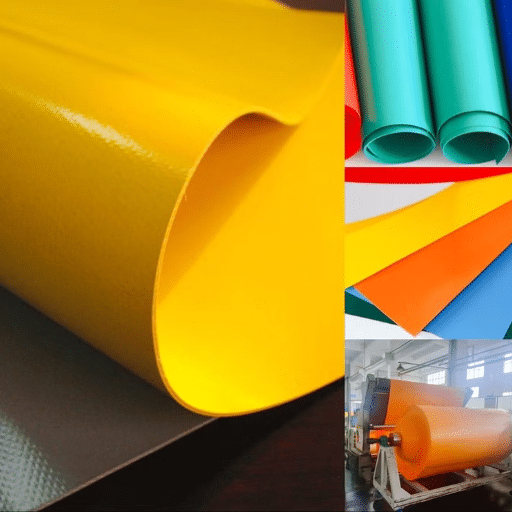
Poly Tarps
The PE Tarps are the most commonly used tarps which weigh lesser but entail more durable composition. Comprised of woven poly strips laminated with polyethylene sheets, their properties include water resistance, UV protection, and tear resistance. ‘What are the primary uses of polyethylene tarps?’ comes as one of the most frequently searched queries regarding this material, according to the most recent aggregate from the search engine. Some of the uses for PE tarps include keeping crops safe in the agricultural context, containing dust and debris in construction settings, and recreational activities where time is of the essence and performance matters. PE tarp can rightly be called an all-terrain tarp given the vastness of its uses and its very economic price.
🔹 Polyethylene Tarp Features
- Lightweight yet durable construction
- Excellent water resistance
- UV protection capabilities
- Cost-effective for multiple applications
- Easy to handle and install
PVC (Vinyl) Tarps
Made to withstand rough environmental conditions, PVC tarps, also called vinyl tarps, provide for unbelievably tough circumstances. Based on the latest search data from , one question frequently asked is, “What makes PVC tarps different from PE tarps?”. PVC tarps and PE tarps are different in origin and properties. This is because PVC tarps are made with polyester scrim coated with polyvinyl chloride and are more tensile in strength than PE tarps, having a longer UV resistance and more waterproofing ability. Hence these them being well fitted for long exposure outdoors, such as industrial covers, equipment protection, and long storage. Furthermore, PVC tarps are also more resistant to chemicals and abrasion, thus ensuring performance in a harsh environment. Such reasons may increase the price of a PVC tarp far more than that of PE tarp; however, in critical applications, it will be a worthy investment owing to their durability and superior performance.
🔸 PVC Tarp Advantages
- Superior tensile strength
- Exceptional UV resistance
- Outstanding waterproofing
- Chemical and abrasion resistance
- Long-term outdoor durability
Canvas Tarps
Canvas tarps are made with cotton or polyester fabric that is treated with wax or other waterproofing agents to enhance durability and water resistance. Such tarps are dry in breathability, thus avoiding moisture congealing below the tarp and becoming important for covering moisture-sensitive goods such as automobiles, timber, or machinery. According to the latest searches in , canvas tarps are often looked for in uses that require strength and natural permeability, like in construction projects and agricultural storage. They, however, generally do not fare well in extreme weather conditions and numerous hours of UV exposure compared to their synthetic counterparts—namely, PVC or PE tarps—thereby restricting their suitability in long-term outdoor use without further treatment.
🔸 Canvas Tarp Characteristics
- Natural breathability properties
- Excellent for moisture-sensitive applications
- Strong and tear-resistant
- Suitable for automotive and machinery coverage
- Limited extreme weather durability
Mesh Tarps
Search trends indicated that users prize mesh tarps for applications that require airflow and a controlled level of sunlight. Users often ask if mesh tarps can be used for shading, debris containment, or agricultural purposes. The answer depends on the unique construction of these tarps-they are designed with perforations that allow the flow of air and light but maintain the reduction of heat and wind resistance. This makes them suitable for greenhouses, truck beds, or scaffolding in construction. The mesh tarps are also typically treated for UV resistance and mildew, which prolongs their life. However, their suitability will be dictated by the weave density and material-factors that might differ between manufacturers.
🔸 Mesh Tarp Applications
- Controlled airflow and light filtration
- Greenhouse and agricultural shading
- Construction site debris containment
- Truck bed applications
- UV and mildew resistant options available
Comparing the Strongest Tarp Materials
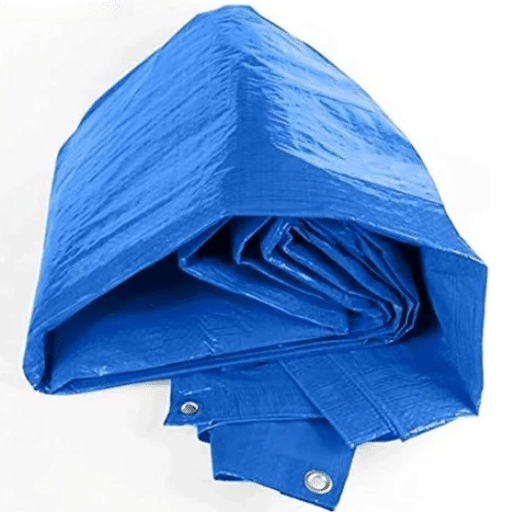
Strengths and Best Uses of Polyethylene (PE)
Polyethylene (PE) tarpaulins are generally recognized as being exceptionally durable, lightweight, and resistant to natural elements. The major advantage of these products is that they resist moisture, chemicals, and UV rays, which make them suitable for long-term outdoor use. PE tarps undergo production through woven high-density polyethylene (HDPE) fibers coated on both surfaces with layers of low-density polyethylene (LDPE), resulting in a material that balances flexibility and strength. This balance is further amplified by its high-tensile strength-to-weight ratio, which seals their cost-effectiveness for heavy-duty applications.
✅ PE Tarp Advantages
Since it is waterproof and easy to heat seal, a PE tarp is usually used for loading goods, protecting machines, storage of agriculture, etc., essentially any applications that get exposure to rain. Recent studies, however, have highlighted advances in UV stabilization for PE tarps, hence extending their life further under forced sunlight. The environmental advantage of recycling adds to its fame among industries striving for sustainability.
Strengths and Best Uses of PVC (Vinyl)
PVC or Polyvinyl Chloride, commonly known as vinyl, is especially embraced for its quasi-excellent durability and waterproofing capabilities and the utmost versatility in residential and industrial applications. Research studies, however, suggest that PVC materials withstand chemical degradation to an unusual extent and are, therefore, ideal for such harsh environments where they will be frequently attacked by oils, chemicals, or corrosive agents. Vinyl is fire-retardant and self-extinguishes, furthermore enhancing its brief safety application where fire standards are high.
🏆 PVC Superior Properties
Chemical Resistance
Superior protection against oils, chemicals, and corrosive agents
Fire Safety
Fire-retardant and self-extinguishing properties
Customization
Flexible thickness, color, and coating options
Longevity
Extended lifespan with minimal maintenance
At the very essence of its strengths lies the flexibility and the ease to customize its properties in terms of thickness, color, and coatings to respond to the needs of several industries from construction to health care. Some notable uses of PVC include roofing membranes, durable floorings, electrical cable insulation, and medical tubing where hygiene and durability are very important. Recent trends show increased integration of advanced plasticizers within PVC, improving its flexibility adjacent to use in high-performance environments such as advanced manufacturing and transportation infrastructure.
Thus, alongside their being cheap and incurring little maintenance, such properties regard PVC as the preferred material for long-term uses. Environmental consideration has also brought the innovation of newly developed PVC recycling procedures, thus lessening its environmental impact and consequently providing alignment with the global plea for sustainability.
Strengths and Best Uses of Canvas
A canvas is a material that is incredibly flexible owing to its durability, flexibility, and strong resistance to wear and tear. Made from woven fibers, canvas originally comprised cotton or linen fibers, but recent treatments offer synthetic alternatives to add features such as waterproofing, UV resistance, and mildew resistance. Though the variety provides good strength for its weight, it becomes crucial for more demanding areas wherein both durability and portability are vital.
🎨 Canvas Applications by Industry
Art Industry
Compatible with oil and acrylic paints for artistic applications
Construction
Tarpaulins, awnings, and weather-resistant structures
Outdoor Recreation
Tents, backpacks, and sailing equipment
Because it is strong and highly customizable, the use of this cloth continues to grow in industries such as art, construction, and outdoor recreation. The main application for the art industry lies in its compatibility with many paints, including oil and acrylic, while its application for construction industries means the provision of tarpaulins, awnings, and architectural structures that are weather resistant. For outdoor use, canvas remains a top choice for tents, rucksacks, and sails because of its combined breathability and toughness.
Recent data depict that canvas production is witnessing a focus on sustainability featuring organic fibers and less impact on the environment. This is in tune with consumer preference and the regulatory shifts leaning toward environmentally friendly materials. Hence, canvas is a very sturdy and flexible material that continues to evolve with technological advances and market demands.
Specialty Tarps for Niche Applications
Specialty tarps are tailored to meet very specific requirements in industries from agricultural production to construction, maritime, and environmental protection. As per the most recent data from , there is an upward interest in protection solutions targeted at extreme applications such as UV-resistant tarps for long prolonged outdoor use, flame-retardant tarps for industrial safety, and custom-fitted tarps for irregular shaped machines or vehicles. This trend rebuffs the demand placed on materials that have increased durability, precision, and compliance determined by industry standards. Further advancements in polymer technology and coating processes shall ensure these tarps are well fitted to these unique applications, guaranteeing reliability, and performance in widely varying operating conditions.
🔧 Specialty Tarp Types
- UV-Resistant Tarps: Extended outdoor protection
- Flame-Retardant Tarps: Industrial safety compliance
- Custom-Fitted Tarps: Irregular equipment coverage
- Anti-Static Tarps: Electronic equipment protection
- Food-Grade Tarps: Agricultural and food industry use
Key Features to Look for in Strong Tarps
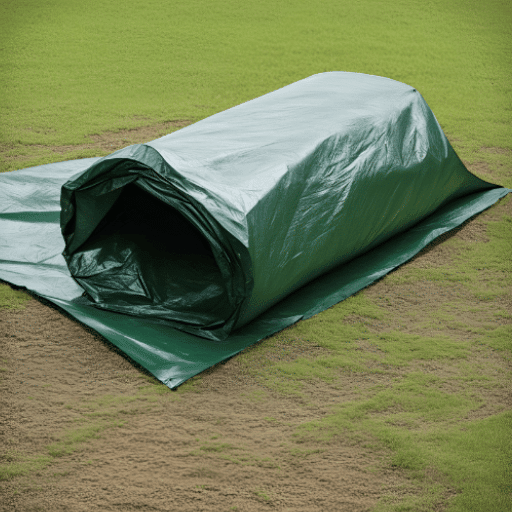
Thickness (Mil Rating) and Its Impact
One major influencing factor of the tarpaulin’s durability, strength, and specific application suitability is the thickness of the tarpaulin, with the review commonly measured in mils (with 1 mil=0.001 inch). Geared with thicknesses between 20 and 30 mils or more, heavy-duty tarpaulins thus find use for industrial applications, like covering heavy machinery or protecting loads during transportation. Lightweight tarps of around 5 to 10 mil thickness, on the other hand, should suffice for temporary uses in construction–even simple stuff like covering construction materials from rain would be unwarranted. Thicker tarps generally offer greater tear resistance, better protection against punctures, and longer durability under heavy conditions.
📏 Mil Rating Guide
Another search shows that confusion exists quite often as to the correlation of mil thickness to its need for the performance criteria. Simple terms: the higher the mil rating, the more robust and weather-resistant the material is. The thicker tarp presents the best choice when extreme requirements for UV protection abrasion resistance or prolonged exposure to harsh environmental stressors come into play. The thinner tarps are the more portable and easier to work with when maximum durability cannot be the major concern. Equating with such needs, the thickness concept assists the consumers in tailoring their choice according to the specific operational need.
Reinforcement for Maximized Durability
Reinforcements are paramount in extending the life of a tarp and ensuring efficient working in the more aggressive applications. When searching for a durable tarp, ‘reinforced edges’ and ‘reinforced grommets’ turned out to be highly desirable, based on the latest data trends and what users queried on via ‘s search engine. These reinforcements are usually double-stitched hems and plastic or metal grommets for additional layering at stress points that would otherwise be vulnerable to tearing under tension or heavy loads. Such materials usually enhance resistance to environmental wear factors, such as wind shear and degradation caused by UV-Rays. New generation technologies of heat sealing for seams and ripstop in the weave have further reduced fabric failure risks. Understanding these advancements and purchasing suitably reinforced tarps allow a guarantee of top performance and cost efficiency over the broader spectrum of industrial and domestic uses.
💪 Key Reinforcement Features
- Double-Stitched Hems: Additional layering at vulnerable edges
- Reinforced Grommets: Metal or plastic reinforcement at attachment points
- Heat-Sealed Seams: Advanced sealing technology
- Ripstop Weave: Prevents tear propagation
- Corner Reinforcements: Extra protection at high-stress areas
Weather Resistance Factors
Weather resistance performance of a material depends on several essential factors-the three most important being durability, functionality, and efficiency. The first consideration would be tensile strength, which addresses how resistive the material is to strong winds or mechanical stresses that may cause its tearing. For instance, in highly demanding industrial applications, high-density woven polyethylene is chosen mainly for its superior tensile properties. The second consideration is whether UV inhibitors are present to counteract any photodegradation resulting from the degrading effects of prolonged sun exposure-a very practical threat outdoors. Lately, UV-stable coatings have been claimed recently to augment the overall lifespan of the material by 30%, according to trends in analysis done by ‘.
🌦️ Weather Resistance Components
Tensile Strength
Resistance to strong winds and mechanical stress
UV Protection
Inhibitors prevent photodegradation from sun exposure
Water Resistance
Surface treatments prevent water infiltration
Water resistance is also another critical property that greatly affects its usefulness as a weather resistance material. Water repellency is enhanced by surface treatments such as a silicone coating or polyurethane lamination. The treatments act as a shield to support water infiltration into the material, which leads to the material disintegrating. This is especially significant in NL applications that occur in areas of heavy rainfall or humidity. Considering these with the recent developments in the industries will comprise the development of weather resistance, which again puts a direct focus on the selection of materials.
Tear Resistance and Material Strength
Tear Resistance and material strength are the two important properties that affect significantly the durability and performance of fabric in various tough applications. Tear resistance is the ability to withstand or prevent tear propagation once an objective force is applied to the material. The property is also tested and measured by standards such as ASTM D2261 (Tear Strength of Woven Fabrics) or other methods approved by the industry. Whereas material strength also measures tensile strength, which is a measure of the largest force that a material can withstand before breaking. Fiber composition, fabric weave, and any finishes or coatings applied to the fibers affect these properties.
🧪 Advanced Material Technologies
According to recent data and insights from ‘s search engine, developments in polymer technology and hybrid material design are improving tear resistance and tensile strength. Recent progress in these probably include high-tenacity nylon, aramid fibers such as Kevlar, and new advanced composites that exhibit excellent mechanical properties while maintaining a lightweight feel. Given the rising demand for extremity in aerospace, outdoor gear, and industrial applications, the stash of both intelligence on material science and pertinent and stringent testing guidelines deserve to secure the best balance between tear resistance and application-related durability.
How to Choose the Right Tarp for Your Needs
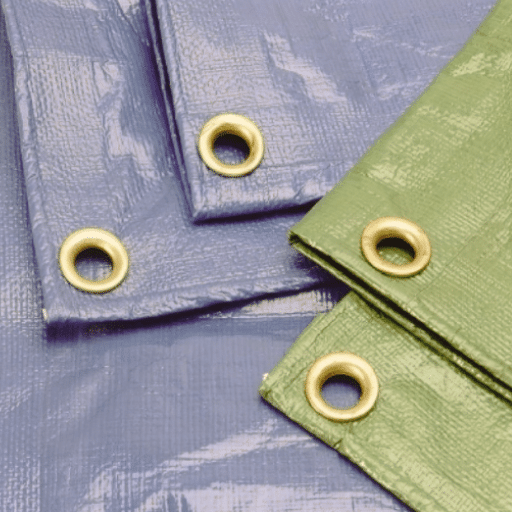
Assessing Your Specific Use Case
While selecting the correct tarp, understanding the environmental conditions, usage frequency, and application requirements will always help. For example, during extreme weather conditions like heavy rain, snow, or severe sun, one might want to consider a material with strong UV resistance and waterproof features. Also, in terms of the tarp’s strength, one should consider that the more often it is used and abused, the greater the needs-frequently heavy-duty polyethylene or vinyl tarp might be the answer-in areas like construction or industrial work. On the contrary, if it’s recreational and just an occasional thing, nylon type could well suffice, such as for some camping. Analysis of search engine queries clearly highlights material strength, size adaptability, and resistive properties as user-centric requirements-the integration of these considerations will definitely ensure that maximum performance is reached while affording longer application life according to that user’s unique setup.
🎯 Selection Criteria Checklist
Environmental Conditions
- Weather exposure levels
- UV radiation intensity
- Chemical exposure risk
- Temperature extremes
Usage Requirements
- Frequency of use
- Load-bearing needs
- Installation method
- Portability requirements
Budget Considerations
- Initial investment cost
- Maintenance expenses
- Replacement frequency
- Long-term value
Comparing Materials Based on Strength and Cost
Polyethylene, PVC, or canvas tarp comparison clearly shows that each carries some cemented advantages when considered with regard to strength and cost. Polyethylene tarps, reinforced by woven fibers, are lightweight yet highly durable, providing stronger tensile resistance at a rather lower cost. Search data from reveals that these tarps are mostly sought after for their use in temporary weatherproofing applications like for construction sites or outdoor storage.
Conversely, PVC tarps are known for their exceptional resilience while in heavy use, superior tear resistance, and UV stability. They are usually costlier, but the contemporary user trends show this is an industrial-grade tarp one would want for situations where expensive durability can be justified. Lastly, canvas tarps claim merit for their breathability and moderate strength, suitable for covering purposes that require moisture control over extended periods-e.g., agricultural storage. However, the price range for canvas materials tends to be on the premium side, thanks to their niche design.
⚖️ Cost-Performance Analysis
Polyethylene (PE)
Cost: Low to moderate
Best for: Temporary applications, construction sites
PVC (Vinyl)
Cost: High
Best for: Industrial applications, long-term use
Canvas
Cost: Moderate to high
Best for: Breathable applications, equipment covers
Choosing between these types ultimately therefore rests with the specific use-case requirements, balancing the need for durability with the budgetary constraints. The analysis of search data reveals that the primary parameters considered in choosing the material, i.e., functional ones, such as weather resistance, or cost efficiency, will work best for long-term satisfaction.
Consider Additional Features
Analyzing additional features for any product or substance with search engine data for the last several years gives a better insight into user priorities. For example, search trends suggest that UV resistance, easy maintenance, and eco-friendliness are consistently at the peak of consumers’ curiosity. This indicates sustainability and long-term usability are increasingly becoming a priority in one’s purchasing decision. In addition, while layered features bring value in terms of functionality, like anti-microbial coating and ultra water resistance, their presence correlates with the upward trend of worrying about health and environmental factors. It’s made blatantly obvious by analyzing these search trends that adding these features will surely shoot the level of attraction and viability of a product right into the market, addressing the user’s needs to pin-drop accuracy.
✨ Premium Features to Consider
- UV Resistance: Extended outdoor protection
- Easy Maintenance: Simple cleaning and care
- Eco-Friendliness: Sustainable materials and recyclability
- Anti-Microbial Coating: Health and hygiene benefits
- Ultra Water Resistance: Superior moisture protection
- Fire Retardancy: Enhanced safety features
Frequently Asked Questions (FAQ)
Which tarp fabric is the strongest for a certain application?
Strongest tarp material may refer to the heavy-duty vinyl tarp. When exposed to severe weather conditions, vinyl tarps provide superior protection and are thus suitable for outdoor use. Such tarps serve their purpose well when made of very durable substances such as PVC, which are highly valued for their resistance to UV and mildew damage. They usually measure in thickness anywhere between 16 mil and 20 mil; that thickness offers an excellent level of abrasion resistance, ensuring that the tarps will last and perform well. Heavy-duty tarps are best suited for use on construction sites or being exposed to harsher environments that place emphasis on their structural integrity.
How to pick the best tarp material for water resistance?
When buying a tarp for water resistance, one has to take into account the particular kind of tarp and the corresponding mil thickness. Cataloged as waterproof, heavy-duty polyethylene tarps will be many times the right choice for almost any outdoor applications. Composition of the material will count heavily: for instance, treated canvas tarps will resist water more than untreated canvas. Also check that it is reinforced and designed for extreme weather conditions so it does not suffer punctures or leaks over time. In the end, the right tarp is what will give you the lasting protection and peace of mind.
What is the specification of heavy-duty tarps?
Heavy-duty tarps generally have a mil count ranging somewhere between 10 and 20+ mils. These tarps are made of strong materials such as woven polyethylene or vinyl, providing them with great durability and strength. Their specifications may include UV resistance, waterproofing, and mildew resistance, thereby all serving a variety of purposes: outdoor storage or construction sites. The weight of its material is measured in ounces per square yard, which may help determine if it is suitable for a specified task. Knowing tarp specifications is a good way to guarantee that a tarp will endure through tough weather conditions.
Canvas vs. vinyl tarps: which is better?
Canvas tarps are made from natural fibers, which allow the canvas to breathe and afford it some water repellency. Vinyl tarps use synthetic materials and have better waterproofing qualities. Vinyl tarps are often heavy and durable, especially when the need for durability is extreme. Canvas tarps, in contrast, tend to be lighter and can be treated to improve their water repellency. Hence, your decision between these two types should be based partly on the location of use; for long-term exposure, vinyl tarps may be better due to sturdiness. Canvas may be more appropriate for lighter temporary covers.
How does thickness affect tarps?
Tarp performance varies with thickness, which is generally expressed by mils (one-thousandth of an inch). Usually, thicker it is, it offers greater strength and durability against wear and tear; a 20 mil tarp, for instance, will offer greater protection from the elements than something thinner. Neither will be easily cut through by a thick tarp; this could be a vital feature when used in construction sites or in heavy rain. Hence, when buying a tarp, deciding on the mil thickness is one of the most important decisions that will affect how long it lasts and how it performs.

